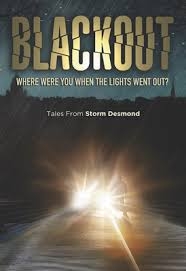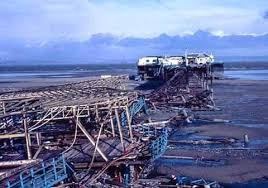
By Peter Wade
The Dukes in Lancaster will be presenting Blackout – Where were you when the lights went out? from 13 October to 3 November. The drama by Sarah McDonald-Hughes sets out to tell the stories of ordinary lives in extraordinary circumstances during and after Storm Desmond. It was at around 10.45pm on Saturday 5 December 2015 that the lights went out across Morecambe, Lancaster and Carnforth, plunging 100,000 people into darkness. Communication and transport were both affected.
My diary from the time recalls the events.
4 December
The rain from Storm Desmond had set in by the time of my return to Barrow railway station. Various young people sheltering … then we were off, rain lashing the windows … Back by bus and a final walk into the gale.
5 December
High winds and still raining. Red flood alerts for Cumbria. A day to stay in … Pools of water growing on the fields.
6 December
Power cut overnight. At an unknown hour looked out from a darkened house over a dark landscape – an eerie greenish sky with only car headlights to pierce the gloom. Glow over the power stations and some light towards Middleton. Still no power by morning. The cooker clock showed it went off at about 10.40. Tea and toast by candlelight with matches to light the gas and an old kettle to make hot water.
Rigged up a Walkman to get news. On Radio 4 there were reports of 55,000 homes without power in Lancaster and Morecambe. Local radio stations indicated a flooded sub-station at Caton Road.
By torchlight to SW’s. Not a total blackout with patches of lighting along Devonshire Rd and Regent Rd towards the West End, round the fire station on Westgate and at Salt Ayre and Asda where a generator was rumbling away. Road block at Scale Hall so no road traffic towards the Millenium Bridge with both Greyhound and Skerton Bridges closed.
SW surprised I’d made the journey and so not really expecting me. Improvised tea. Listened to The Bay whose ground floor quayside studios had been flooded. Instead they were broadcasting from an upper room and inviting passing traffic to sound their horns (many did). SW had been out into town going over Carlisle Bridge and up Castle Hill where a crowd had gathered trying to get mobile phone signals. Flooding had affected the bus station and underground car parks.
Back home again by torchlight though by then hazy stars had been replaced by cloud. A surprising number of people out and about in Lancaster, many with torches but not all as they emerged suddenly from the darkness. Little change on the way back aside from a pool of lights crowning Higher Heysham and the sign at Tibicar Garage.
Concerned message from CC on the answerphone.
7 December
Chorus of distant alarms at 5am. Power restored after a break of 30 and a half hours.
Morning call from RA at Carnforth where diverted traffic was passing through. Hillcroft Nursing Home had been evacuated. Reports from Shap that Stepps Hall had escaped flooding by a bare millimetre.
Quiet out. Central Printing closed, Arndale sparse and I was a solitary shopper in Stationery 4 Less.
Power off again at 4pm. At least managed some washing and washing up.
8 December
Still no power when I got up for an early breakfast at what turned out to be before 6. Back to bed then chorus of alarms. After several false starts power was restored by 7.
Down to almost my last drop of milk so off to the shops. Aldi open but no dairy or chilled products so stocked up on bread and non-perishables. Morrisons had plenty of dairy so finished shop there.
Broken window and scatter of stones below Heysham High’s maths building bore witness to someone making the most of the cover of darkness.
9 December
Lots of flood pictures in this week’s Visitor but not so many blackout ones (!). The front page headline was though ‘Blackout!’
